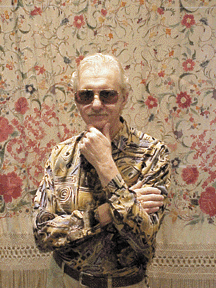|
Articles:
In the
beginning | Drawing
conclusions

Drawing conclusions
For a lifetime -- not to mention 29 years
at TCU -- Don Ivan Punchatz has made his point by sketching whole other worlds.
By Nancy Bartosek

 Intelligent
in conversation, comfortable in demeanor, Don Ivan Punchatz is the kind of guy
you'd like living next door.
Intelligent
in conversation, comfortable in demeanor, Don Ivan Punchatz is the kind of guy
you'd like living next door.
Yet, from this 60-year-old's nationally
recognized hand pours people so real they frighten, creations so unreal they
astonish. His silent voice is intense, outspoken; his social conscience keen,
connecting what people see in his work with what's going on in our world.
TIME, Playboy, Esquire, National Lampoon,
Rolling Stone, Boy's Life, Newsweek have all commissioned his work for their
covers. His portfolio stretches from photo-realistic images of Elvis and
presidential aspirant Pat Robertson to fantasy creatures for sci-fi novelists
like Issac Asimov and the computer game Doom, even to friendly pen and ink
prints for the children's Wishbone series. Original works hang in museums,
private collections and galleries, including the Smithsonian Institution's
National Portrait Gallery. His images grace posters, album covers, greeting
cards and national advertisements.
Punchatz has been called an artistic chameleon,
able to dress his subjects in the latest and greatest fashions of the ages.
"I'm always being asked to do a sort-of-like," Punchatz said. Sort of
like Monet, or Dali, or Disney. Now others strive for sort-of-like Punchatz.
And it all sort-of began for this former New
Jersey boy with cartoons. Entranced as a child by Disney animation and newspaper
comic strips like Prince Valiant and Tarzan, Punchatz fed himself a daily diet
of visual stimulation. A nearby paper company provided an endless supply of
discarded comic books, and by age 13 Punchatz was free-lancing his talents to a
local cartoonist, illustrating comic strips for children's religious
publications.
Punchatz's talent landed him a scholarship to
the New York School of Visual Arts, where he blossomed under the tutelage of his
idol and Tarzan illustrator, Burne Hogarth.
"He had so many interests in terms of
science and philosophy," said Punchatz of his mentor. "He'd tell me,
'Don't just look at the narrow field of what you're interested in, here's the
world of art.' "
Hogarth even had his young study reading
authors like James Joyce and Herman Hesse for inspiration.
Punchatz's art came of age in the 1960s, a time
when sex, drugs and rock and roll permeated the media and the country.
Unpreten-tiously hip and cutting edge, Punchatz showed his audience things they
didn't know in things they recognized.
When Penthouse commissioned a piece to
illustrate the failed rescue of American hostages in Iran that ended in a desert
crash, Punchatz settled on a striking image of a dead eagle splayed out on a
barren sandscape. Another piece that ran in Oui featured a junkie's arm
full of disturbing needle holes, which formed a map illustrating changing heroin
trade routes in Europe.
Sometimes when Punchatz's work is done, he
finds his own demons lurking in unplanned images. It wasn't until he was in his
40s that Punchatz realized his obsession with hidden, sexually charged imagery
stemmed from a childhood incident of molestation. One illustration in his
personal collection, a frantic-eyed turtle suspended in space, was painted
during a fierce personal battle with cancer in the '80s. It wasn't until later
that he linked the turtle to his own feelings of helplessness.
"As a child I saw these older kids who
thought it great sport to toss this turtle off a bridge," he said, eyes
revealing the lingering pain he still felt. "It would land on concrete, and
they kept tossing it until it was smashed apart. It was that feeling of watching
that horrible brutal kind of behavior and not being able to do anything."
In 1969, Punchatz moved his wife, Sandra, and
children -- Triska now 39, and Gregor, 34 -- to Fort Worth to be near extended
family. He opened his renowned Sketch Pad studio the next year and arrived on
TCU's steps looking for interns. In addition to finding talent for his studio,
Punchatz landed a spot at the school, temporarily replacing a professor on
sabbatical. At the end of Punchatz's semester stay, students lobbied to keep
him, and he's been teaching ever since.
After hundreds of pictures worthy of a billion
words, Punchatz is still in high demand. He'd like to be "extraordinarily
wealthy and never have to worry about bills and paint and draw at leisure,"
but instead he's still working, pushing students to develop their skills and
hone their business acumen. Illustration is a competitive venture and even the
most creative designer must know how to please the customer.
"Idea creation is the same as scientific
exploration -- intense research followed by physically working through
ideas," he said. "It involves translating the images in the mind so
they can be seen out there" -- he gestures toward his forehead --
"instead of in here."
Top
|



